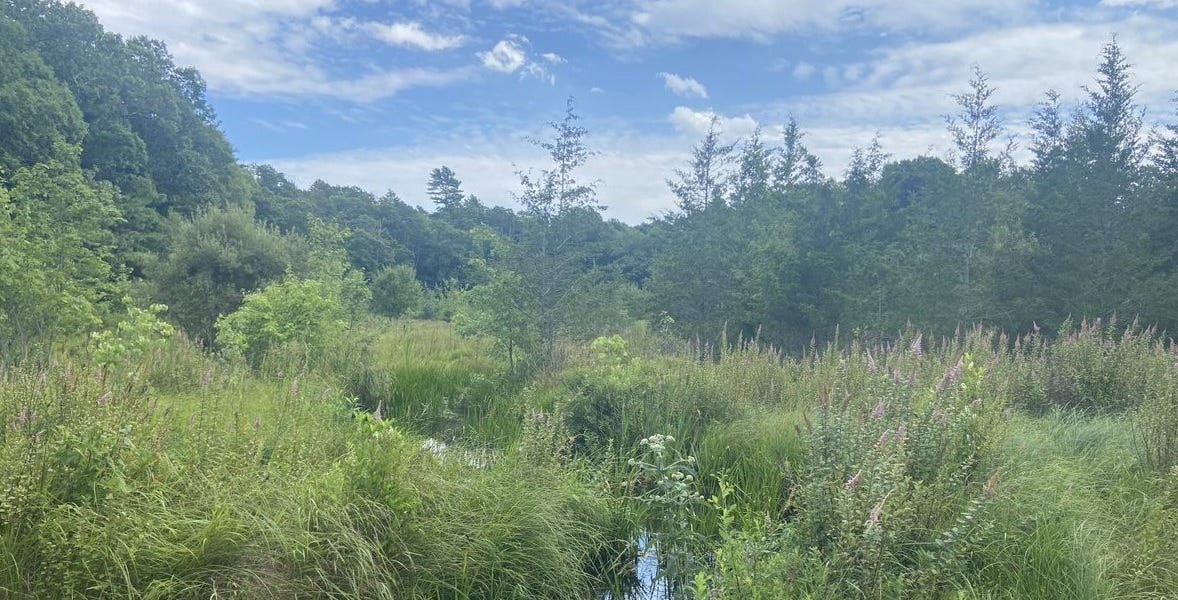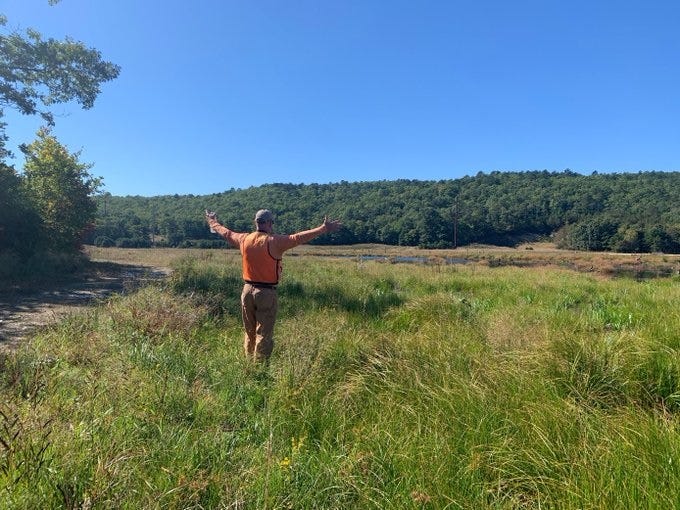In the People’s Republic of Massachusetts, the cranberry business used to be a big part of the economy, going back to when child labor was a thing, even. Around the turn of this century, however, the cranberry industry started being pinched by a worldwide cranberry glut, with growers in Wisconsin and Quebec harvesting so many berries that the market crashed, leading many to get out of the business.
But what to do with the former berrylands? Farmers could probably sell out to developers, but that wasn’t necessarily something they wanted to see. Fortunately, crazy environmentalist hippies and ecologists (same thing) had an idea: How about restoring the bogs to be wetlands again, like they were before getting covered in sand for cran-griculture?
This nifty article at the well-named “Reasons To Be Cheerful” website explains how a former 600-acre cranberry farm called Tidmarsh was converted/restored into a healthy wetland after owners Glorianna Davenport and her husband, Evan Schulman, got out of the cranberry business in 2008-2010. They decided to turn the farm into wetlands — at the time, a new venture in ecology, helped along by a coalition of environmental groups, and in 2011, the state’s Environmental Protection agency, through its Division of Ecological Restoration.
Perhaps to avoid people giggling all the time at the acronym DER, the agency goes by “MassDER,” which is still funny for fans of Manos: The Hands of Fate. “The MassDER will not be pleased.”
Since 2018, MassDER has gone all in on bog restoration, and currently has 15 such projects going on across the state.
It’s a fun read, and a lovely example of what can be done to help nature come back at a time when climate disruptions need an everything-at-once set of solutions.
When Davenport was getting started on the project, we learn,
It was well-understood at the time that most cranberry bogs in Massachusetts were situated within natural wetlands but had been made more hospitable for cranberries — and stripped of other, undesirable plants — by putting down a fresh layer of sand every few years. Researchers already suspected that many of those wetlands were originally Atlantic white cedar swamps, an ecosystem that’s rare today. Yet evidence was mounting that cranberry bogs that were taken out of production grew into sandy pine and maple forests instead of reverting to the wetlands they were before.
The state was just getting going on its first attempt to restore a former wetland, at the headwaters of the Eel River in Plymouth, where researchers found — after a $2 million project to scrape off 60 acres of former bogland — that there was still wet peaty bog down there under all the sand, and that
the seeds left by those bygone swamps were still alive beneath the cranberry bogs. The researchers planted thousands of white cedar saplings in the seemingly lifeless piles of mud the project left in its wake. It wasn’t long before a thick carpet of native mosses, rushes, sedges and wildflowers sprouted around the young trees.
In more recent bog restorations, MassDER’s website explains, since removing all the sand is prohibitively expensive, other steps can be used to break up and saturate the sandy layers of soil that cover old wetlands, like roughening the surface and breaking up matted cranberry roots, filling in ditches, and restoring stream flows by pulling out old irrigation dams. Get everything nice and soggy, and soon enough,
Native wetland plants grow quickly from buried and dormant seed. If done right, little future human maintenance is needed. Only patience is required as the site heals and turns back into healthy wetlands over the following years.
For some fun photos to make you feel hopeful about our much-abused planet, check out MassDER’s Xitter stream, which has a lot of neato before and after photos of former bogs. From 2021, here’s a pair of pics of the same former bog just a year after the first phase of construction was finished in 2020:
After wetlands are restored, most become part of the state park system, with walking trails and birds and critters and such. As for the former Tidmarsh farm, its restoration was completed in 2016; Mass Audubon purchased the site in 2017 and it’s now open to the public as a wildlife sanctuary. Mass Audubon brags that it’s “the largest freshwater ecological restoration ever completed in the Northeast.” Hard to believe that this was once a cranberry farm, and then every bit as muddy and desolate-looking as the first of those MassDER pics above.
And this isn’t just about having nice places for wildlife and for coastal elitists to go birding; it’s a way to make good use of agricultural land that, thanks to climate change, is becoming economically less viable for cranberry crops. Once restored to wetlands, though, you’re doing some serious climate adaptation and resilience:
Wetlands are effective at storing carbon and filtering overabundant nutrients like nitrogen out of water. They provide good fish habitat and are rife with opportunities for recreation. And they can serve as buffers that shield nearby communities from flooding and sea-level rise. Protecting and restoring wetlands has been a recent priority among conservationists in part because it’s hard to replicate them in places they don’t naturally occur.
Of course, it certainly helps to have a state government that’s willing to invest in projects like these, instead of pretending that nothing needs to be addressed, oh, there we go getting all political again.
[Reasons to be Cheerful / Massachusetts Department of Ecological Restoration]
Yr Wonkette is funded entirely by reader donations. If you can, please subscribe, or if a one-time donation is better for you, then that’s obviously good for us!




